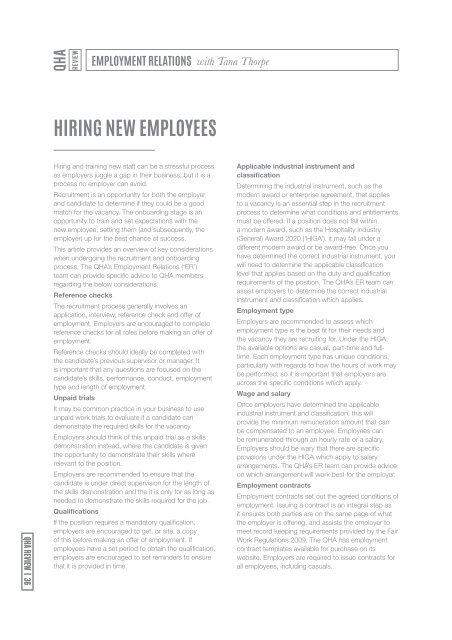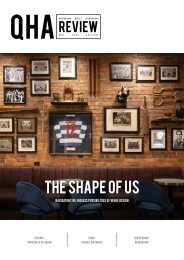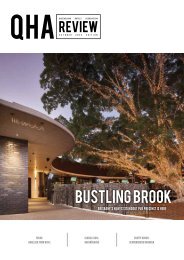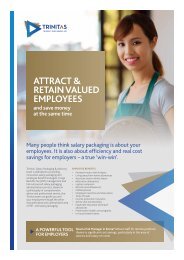QHA-Review_July_digital
You also want an ePaper? Increase the reach of your titles
YUMPU automatically turns print PDFs into web optimized ePapers that Google loves.
EMPLOYMENT RELATIONS<br />
with Tana Thorpe<br />
HIRING NEW EMPLOYEES<br />
<strong>QHA</strong> REVIEW | 36<br />
Hiring and training new staff can be a stressful process<br />
as employers juggle a gap in their business, but it is a<br />
process no employer can avoid.<br />
Recruitment is an opportunity for both the employer<br />
and candidate to determine if they could be a good<br />
match for the vacancy. The onboarding stage is an<br />
opportunity to train and set expectations with the<br />
new employee, setting them (and subsequently, the<br />
employer) up for the best chance of success.<br />
This article provides an overview of key considerations<br />
when undergoing the recruitment and onboarding<br />
process. The <strong>QHA</strong>’s Employment Relations (‘ER’)<br />
team can provide specific advice to <strong>QHA</strong> members<br />
regarding the below considerations.<br />
Reference checks<br />
The recruitment process generally involves an<br />
application, interview, reference check and offer of<br />
employment. Employers are encouraged to complete<br />
reference checks for all roles before making an offer of<br />
employment.<br />
Reference checks should ideally be completed with<br />
the candidate’s previous supervisor or manager. It<br />
is important that any questions are focused on the<br />
candidate’s skills, performance, conduct, employment<br />
type and length of employment.<br />
Unpaid trials<br />
It may be common practice in your business to use<br />
unpaid work trials to evaluate if a candidate can<br />
demonstrate the required skills for the vacancy.<br />
Employers should think of this unpaid trial as a skills<br />
demonstration instead, where the candidate is given<br />
the opportunity to demonstrate their skills where<br />
relevant to the position.<br />
Employers are recommended to ensure that the<br />
candidate is under direct supervision for the length of<br />
the skills demonstration and the it is only for as long as<br />
needed to demonstrate the skills required for the job.<br />
Qualifications<br />
If the position requires a mandatory qualification,<br />
employers are encouraged to get, or site, a copy<br />
of this before making an offer of employment. If<br />
employees have a set period to obtain the qualification,<br />
employers are encouraged to set reminders to ensure<br />
that it is provided in time.<br />
Applicable industrial instrument and<br />
classification<br />
Determining the industrial instrument, such as the<br />
modern award or enterprise agreement, that applies<br />
to a vacancy is an essential step in the recruitment<br />
process to determine what conditions and entitlements<br />
must be offered. If a position does not fall within<br />
a modern award, such as the Hospitality Industry<br />
(General) Award 2020 (‘HIGA’), it may fall under a<br />
different modern award or be award-free. Once you<br />
have determined the correct industrial instrument, you<br />
will need to determine the applicable classification<br />
level that applies based on the duty and qualification<br />
requirements of the position. The <strong>QHA</strong>’s ER team can<br />
assist employers to determine the correct industrial<br />
instrument and classification which applies.<br />
Employment type<br />
Employers are recommended to assess which<br />
employment type is the best fit for their needs and<br />
the vacancy they are recruiting for. Under the HIGA,<br />
the available options are casual, part-time and fulltime.<br />
Each employment type has unique conditions,<br />
particularly with regards to how the hours of work may<br />
be performed, so it is important that employers are<br />
across the specific conditions which apply.<br />
Wage and salary<br />
Once employers have determined the applicable<br />
industrial instrument and classification, this will<br />
provide the minimum remuneration amount that can<br />
be compensated to an employee. Employees can<br />
be remunerated through an hourly rate or a salary.<br />
Employers should be wary that there are specific<br />
provisions under the HIGA which apply to salary<br />
arrangements. The <strong>QHA</strong>’s ER team can provide advice<br />
on which arrangement will work best for the employer.<br />
Employment contracts<br />
Employment contracts set out the agreed conditions of<br />
employment. Issuing a contract is an integral step as<br />
it ensures both parties are on the same page of what<br />
the employer is offering, and assists the employer to<br />
meet record keeping requirements provided by the Fair<br />
Work Regulations 2009. The <strong>QHA</strong> has employment<br />
contract templates available for purchase on its<br />
website. Employers are required to issue contracts for<br />
all employees, including casuals.
















